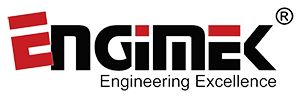At Engimek Valves, we specialise in industrial valves that deliver reliable and efficient flow control solutions for a wide range of industries. Among these, butterfly valves stand out for their compact design, cost-effectiveness, and versatility. Widely used in water treatment, chemical processing, oil and gas, HVAC systems, and more, butterfly valves are a preferred choice for industrial flow control due to their quick operation, low pressure drop, and adaptability.
1. Working Principle of a Butterfly Valve
A butterfly valve is a quarter-turn industrial valve that regulates flow by rotating a disc within the flow path. The main components are:
- Valve Body: Connects to the piping system (wafer or lug-style)
- Disc (Butterfly): Rotates to block or allow flow
- Stem: Connects the actuator or handle to the disc
- Seat: Provides a sealing surface to prevent leakage
- Actuator/Handle: Manually or automatically controls valve position
When closed, the disc is perpendicular to the flow, blocking it. When opened, the disc turns 90 degrees to align with the flow, minimizing obstruction.
2. Common Types of Industrial Butterfly Valves
- Wafer Type: Fits between flanges, held by bolts. Most common and cost-effective for general industrial use.
- Lug Type: Threaded lugs allow installation between two flanges using separate bolts. Suitable for dead-end service.
- Double Offset (High-Performance): Shaft offset reduces seat wear. Handles higher pressure and temperature.
- Triple Offset: Metal-to-metal seating for critical applications requiring bubble-tight shutoff and high temperature resistance.
- Rubber-Lined: Soft-seated for water, air, and low-pressure systems. Corrosion-resistant and economical.
- PTFE-Lined: For aggressive chemicals and acids.
- Metal-Seated: Designed for high-temperature or abrasive services.
3. Industrial Applications of Butterfly Valves
- Water Treatment & Wastewater: Regulating flow in pipelines, tanks, and filtration systems.
- Oil & Gas: Isolation and control in refineries, pipelines, and storage facilities.
- Chemical Processing: PTFE-lined and metal-seated valves for corrosive and high-temperature media.
- HVAC Systems: Controlling air and water flow in heating, ventilation, and cooling.
- Power Generation: Handling high-pressure steam or cooling water circuits.
- Food & Beverage: Sanitary butterfly valves for hygienic environments.
4. Key Advantages of Industrial Butterfly Valves
- Compact Design: Takes up less space compared to other industrial valves.
- Fast Operation: Quarter-turn mechanism ensures quick opening/closing.
- Cost-Effective: Lower installation and maintenance costs.
- Low Pressure Drop: Minimal resistance to flow when fully open.
- Wide Size Range: Available for small pipes to large industrial pipelines.
- Flexible Installation: Suitable for both vertical and horizontal pipelines.
5. Limitations to Consider
- Not suitable for high-pressure drop systems requiring precise throttling.
- Disc remains in the flow, which may cause turbulence or pressure loss.
- Soft-seated valves may wear over time, especially with abrasive media.
- Not ideal for slurry or solid-heavy applications without specialized design.
6. Choosing the Right Industrial Butterfly Valve
- Media Type: Clean water, gas, steam, corrosive fluids, or slurry?
- Pressure and Temperature: Select appropriate valve body and seat materials.
- Valve Function: On/off isolation or throttling?
- Installation Location: Flange standard (ANSI, DIN), space availability.
- Material Requirements: Carbon steel, stainless steel, ductile iron, or lined options.
- Actuation Needs: Manual, electric, or pneumatic?
7. Customization and OEM Options
Many industries require industrial valves customized to specific sizes, connection standards, or coatings. At Engimek Valves, we offer:
- Custom drawings or model-based production
- International flange standards (EN, ANSI, JIS)
- Special coatings like epoxy, PTFE, or black oxide
- Quality control including hydro testing, seat leak testing, and material certification
Industrial butterfly valves are essential components in fluid handling systems across diverse industries. With a variety of types and configurations, selecting the right valve requires understanding your application, media, pressure rating, and environment. Whether you need a wafer-type valve for basic water flow or a triple-offset valve for critical steam isolation, Engimek Valves provides optimal solutions for performance, durability, and value.

